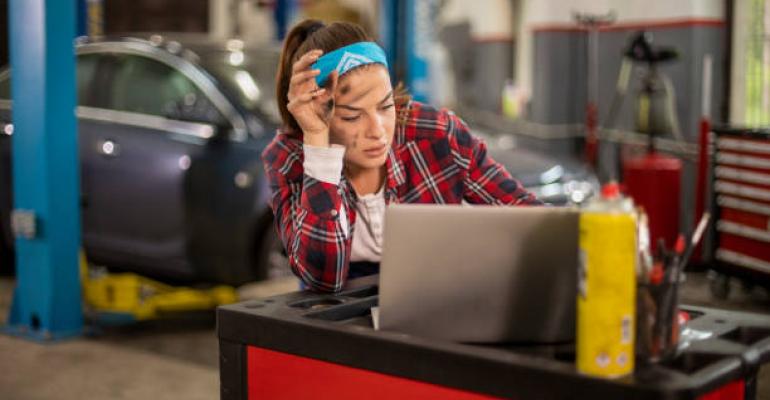In recent years, each summer has been hotter than the last. One result? A negative impact on workplace safety.
According to the U.S. Department of Labor’s Bureau of Labor Statistics, an average of 2,700 environmental heat cases (including 35 deaths) impact workplaces each year.
The EPA, however, states that many heat-related fatalities are underreported due to misdiagnosis. Heat stroke, for example, can be mistaken for heart attack. Accurately diagnosed or not, the effects of heat-related illnesses impact the body for years.
With this in mind, OSHA last year announced a National Emphasis Program (NEP) to protect workers from heat-related illnesses and injuries.
The auto industry needs to take proactive steps compliant with OSHA’s new heat illness rules. Here, we’ll look at some examples of when OSHA may visit the workplace and what automotive industry workers can expect during an inspection.
OSHA Can Inspect Workplaces on Days With Heat Indexes of 80° F+
OSHA’s new guidance focuses on preventing on-the-job heat-related illness, injury and death. Specifically, the NEP targets high-risk workplaces for inspection on “heat priority days” where the heat index is expected to be 80° F or higher.
Scenarios where OSHA may likely inspect for heat stress include:
- Dealership has a reportable injury, such as an employee’s hospitalization due to heart attack, and the heat index was above 80 the day of the incident.
- Employee complaint to OSHA about unsafe heat-related work conditions.
- Pre-planned inspection for combined industry-specific NEPs such as Combustible Dust and Heat.
Additionally, OSHA provides automotive-industry companies outreach and compliance assistance to help ensure the safety of their workers and prevent adverse events before they occur.
Understand What OSHA Examines During an Inspection
In the NEP, OSHA outlines how the Certified Safety and Health Officer (CSHO) will examine specific heat illness-related compliance procedures and their documentation. To stay prepared for this scenario – and avoid any undue stress in the case a CSHO comes knocking – keep the following in mind:
- Complete OSHA 300 Logs and 301 Incident reports (as required by your industry).
- Screen employees for heat-related illness symptoms including headache, dizziness, fainting and dehydration.
- Identify heat-related hazards, review your heat illness and injury program (if there is one) and consider the material outlined throughout Section D of the NEP.
Stop Heat Illness Before It Occurs
OSHA’s heat safety app supports heat-illness prevention by monitoring the local heat index, measuring potential risk and suggesting steps to take for employee protection. This can be especially helpful for salespeople on blacktop lots. (Still, don’t forget to stay current with the signs and risk factors of heat illness.)
To be sure, mitigating heat illness and injury requires mindfulness and training. Consider creating a checklist to ensure you’re providing the proper resources necessary to protect employees, such as:
- Monitoring ambient temperatures.
- Scheduling breaks for rest and hydration.
- Offering access to shaded areas.
- Recognizing signs and symptoms of illness.
- Administering first aid.
- Training employees on off-duty behaviors that can affect their resilience to the heat the following day.
As you create or modify your heat-illness prevention plan, keep these questions in mind:
- Which employees will be on your heat-illness prevention team, and which tasks will each perform? These include checking the heat index, monitoring facility conditions, implementing proper controls and providing supplies and equipment to workers.
- Who will be responsible for monitoring workers’ health in your facilities during high heat index days?
- Have you provided time to acclimatize new and returning employees? (Injuries are most likely to occur during the first days of working in high-heat environments.)
- Do you need to consider providing additional breaks, shade and water?
- Does each workplace, like a service garage or factory floor, provide access to proper personal protective equipment, such as evaporative cooling vests and large fans?
- Do you need to up the frequency of facility reminders for scheduled breaks and hydration?
- Do your procedures sufficiently support the need for rapid response to heat illness once it occurs?
A Federal Standard Isn’t Far Behind
The NEP for heat illness isn’t a matter of federal law, which means your company isn’t legally required to follow the safety procedures necessary to mitigate heat illness. Instead, it outlines areas of particular concern to OSHA. But federal standards are surely just around the corner.
 To prevent injuries and save lives as well as avoid the fines and legal trouble that often accompany workplace-related heat illness, companies need to take proactive steps toward mitigation and training.
To prevent injuries and save lives as well as avoid the fines and legal trouble that often accompany workplace-related heat illness, companies need to take proactive steps toward mitigation and training.
Remember, some states have their own regulations governing heat-related illness prevention – and some even exceed OSHA standards. So be sure to balance state, local and federal laws to develop comprehensive workplace safety standards.
Jason Fritz (pictured, above left) is the team supervisor for the East District at KPA, an EHS and workforce compliance software and services provider for midsize businesses.





